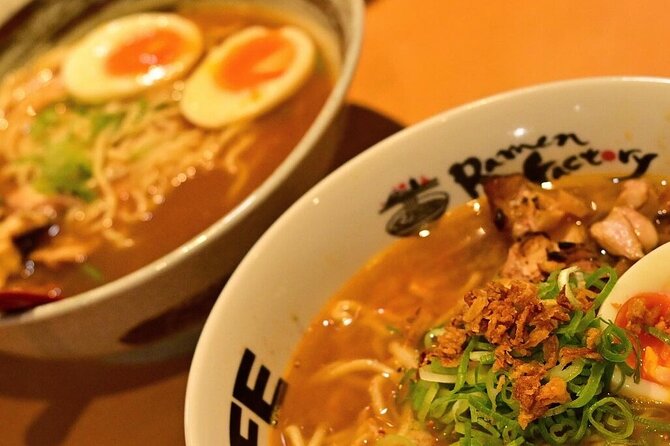In Kyoto, Japan, food enthusiasts and travelers can enjoy the art of ramen-making at the Ramen Factory. This unique cooking class offers participants the chance to learn the secrets behind creating the perfect bowl of this beloved Japanese dish.
With a maximum of 15 travelers per session, guests can enjoy a personalized and intimate learning environment. The Ramen Factory has garnered rave reviews from satisfied customers, promising a memorable and educational experience for those looking to delve into the world of ramen.
Key Takeaways

- Participants gain a deeper appreciation for ramen by exploring its history and visiting renowned shops
- Hands-on experience in making their own bowl of ramen is provided
- Ramen making techniques involve selecting and combining fresh ingredients for a flavorful bowl of noodles
- Tasting and evaluating ramen flavors based on taste, broth consistency, and balance of toppings is important.
The History of Ramen in Kyoto

The knowledge about the history of ramen in Kyoto is shared during the cooking class at Ramen Factory. Participants learn about the evolution of ramen, a popular Japanese dish known for its flavorful broth and noodles.
Kyoto, with its rich culinary traditions, has its own unique ramen culture. The city is home to famous ramen shops that have been serving delicious bowls of noodles for generations. One such shop is Menya Shichisai, known for its rich and creamy tonkotsu ramen. Another popular spot is Honke Daiichiasahi, which has been serving its signature soy sauce-based ramen since 1946.
These iconic establishments, along with many others, have played a significant role in shaping the ramen scene in Kyoto. By exploring the history and visiting these renowned shops, participants of the cooking class gain a deeper appreciation for the beloved dish.
Exploring the Ramen Factory

Has anyone visited the Ramen Factory and tried their handmade noodles?
If not, it’s definitely an experience worth considering. The Ramen Factory offers a unique ramen factory tour experience where visitors can’t only learn about the history and process of making ramen but also get hands-on experience in making their own bowl of ramen.
They offer various ramen making workshops and classes, catering to different levels of expertise. Whether you’re a ramen enthusiast or a beginner, there’s something for everyone.
During the workshops, participants are guided by experienced instructors who share their knowledge and techniques. From kneading the dough to boiling the noodles, every step is carefully taught. It’s a fun and interactive way to appreciate the art of ramen making while enjoying the satisfaction of creating your own delicious bowl of ramen.
Ingredients and Techniques Used in Ramen Making
One of the key techniques used in ramen making is the combination of various ingredients, such as pork bones and soy sauce, to create a flavorful broth. This traditional cooking method has been passed down through generations and is still widely used in ramen shops around the world.
The rich and savory broth, infused with the umami flavors of the pork bones and the depth of the soy sauce, is what sets ramen apart from other noodle soups. This combination of ingredients not only creates a delicious taste, but also evokes a sense of comfort and satisfaction in those who enjoy a bowl of ramen.
The careful balance of flavors and the attention to detail in the cooking process are what make ramen cooking techniques truly special. So next time you slurp down a bowl of ramen, take a moment to appreciate the craftsmanship and skill that goes into creating such a delectable dish.
Step-by-Step Ramen Cooking Process

An essential part of the ramen cooking process is carefully selecting and combining the freshest ingredients to create a flavorful and satisfying bowl of noodles. Ramen cooking techniques vary, but the goal remains the same – to create a delicious and balanced broth, perfectly cooked noodles, and a variety of toppings that add texture and flavor. The key to a great ramen broth lies in simmering bones, meat, and vegetables for hours to extract maximum flavor. Noodles are cooked separately and then added to the broth, ensuring they retain their chewy texture. As for flavor variations, ramen can be customized with different types of broth such as miso, shoyu, or tonkotsu, and toppings like chashu pork, soft-boiled eggs, and seaweed. The possibilities are endless, allowing chefs to create unique and mouthwatering bowls of ramen.
| Ramen Cooking Techniques | Ramen Flavor Variations |
|---|---|
| Simmering bones, meat, and vegetables for hours | Miso, shoyu, or tonkotsu broth |
| Cooking noodles separately and adding them to the broth | Chashu pork, soft-boiled eggs, seaweed, etc. |
Tasting and Evaluating Different Ramen Flavors

He loves trying out new ramen flavors and evaluating them based on their taste, broth consistency, and the balance of toppings.
Ramen flavor preferences can vary greatly from person to person, with some enjoying a rich and savory broth while others prefer a lighter and more subtle flavor. The cooking techniques used to create these flavors are equally diverse, with some chefs opting for a slow simmering process to extract maximum flavor from the ingredients, while others use a quick and intense boil to achieve a different taste profile.
When it comes to evaluating ramen, the taste is of utmost importance. A perfectly balanced broth that’s flavorful without being overwhelming can elevate a bowl of ramen to new heights.
The consistency of the broth is also crucial, with some preferring a thicker, creamier texture while others enjoy a lighter, more brothy consistency.
Lastly, the balance of toppings adds another layer of complexity to the overall flavor profile. From tender slices of chashu pork to crispy bean sprouts and tangy pickled ginger, the combination of toppings can greatly enhance the enjoyment of the ramen.
Tips and Tricks for Perfecting Your Ramen at Home

To perfect your ramen at home, try combining a variety of toppings in odd numbers and using different cooking techniques, such as boiling or simmering, to achieve the desired flavor and consistency. Experimenting with techniques for making vegan ramen can also be a great way to enhance your homemade ramen experience. For those looking to create a plant-based version of this popular dish, there are several techniques to consider. One option is to use vegetable broth as a base, which can be made from scratch or purchased pre-made. Another technique is to incorporate umami-rich ingredients, such as mushrooms or seaweed, to add depth of flavor. Plus, using tofu or tempeh as a protein substitute can give your vegan ramen a satisfying and hearty texture. As for the best ramen toppings, the possibilities are endless. Whether you prefer traditional options like sliced pork or boiled eggs, or more unique choices like corn or nori, the key is to find a combination that complements the flavors of your broth. Here is a table showcasing some popular ramen toppings and their characteristics:
| Topping | Description | Flavor Profile | Texture |
|---|---|---|---|
| Chashu | Tender, braised pork belly | Savory, melt-in-your-mouth | Succulent |
| Soft-boiled Egg | Creamy yolk, tender whites | Rich, savory | Silky, smooth |
| Nori | Roasted seaweed sheets | Umami, slightly salty | Crisp, chewy |
| Bean Sprouts | Crunchy, fresh sprouts | Light, refreshing | Crisp |
Taking Home a Taste of Kyoto: Ramen Factory Souvenirs
The Ramen Factory offers a variety of souvenirs, such as ramen bowls and chopstick sets, that visitors can take home as a taste of Kyoto. The Ramen Factory merchandise isn’t just any ordinary gift shop selection. It’s carefully curated to capture the essence of the Ramen Factory experience and the rich cultural heritage of Kyoto.
Here are three reasons why these souvenirs evoke an emotional response in the audience:
-
Authenticity: Each ramen bowl and chopstick set is handcrafted by local artisans, ensuring that every piece is unique and carries the spirit of Kyoto’s craftsmanship.
-
Connection: Owning a piece of Ramen Factory merchandise allows visitors to bring a part of their Ramen Factory experience back home, creating a lasting connection to the memories made in Kyoto.
-
Inspiration: These souvenirs act as a reminder of the delicious flavors, techniques, and traditions learned during the cooking class, inspiring visitors to recreate their own ramen creations and explore the world of Japanese cuisine.
Frequently Asked Questions
Are There Any Age Restrictions for the Ramen Cooking Class at Ramen Factory in Kyoto?
Age restrictions for the cooking class depend on the specific class and provider. It is recommended to check with the Ramen Factory in Kyoto for any age requirements or restrictions before booking.
Can I Bring My Own Ingredients to the Ramen Cooking Class?
Yes, participants are allowed to bring their own ingredients to the cooking class. The class also accommodates dietary restrictions, with vegetarian and vegan options available upon request after booking.
Is It Possible to Book a Private Ramen Cooking Class for a Group?
Private group bookings are available for the ramen cooking class, allowing participants to have a personalized experience. The class also offers the option to customize ramen recipes to cater to specific dietary preferences or restrictions.
What Is the Duration of the Ramen Cooking Class?
The duration of the ramen cooking class is typically around two hours. During this time, you will learn various techniques for making authentic ramen dishes under the guidance of experienced instructors.
Are There Any Special Dietary Options Available for the Ramen Cooking Class?
Yes, there are special dietary options available for the Ramen Cooking Class. Vegetarian alternatives can be requested post-booking, ensuring that participants with special dietary restrictions can still enjoy the experience.
The Sum Up
To sum it up, the Ramen Factory in Kyoto offers a unique and immersive ramen-making experience for food enthusiasts and travelers.
With its accessibility options, personalized learning environment, and positive customer reviews, it promises a memorable and educational culinary adventure.
Participants can learn about the history of ramen, explore the techniques and ingredients used in its making, and even taste and evaluate different flavors.
With the option to take home souvenirs, guests can continue perfecting their ramen skills long after the class ends.






